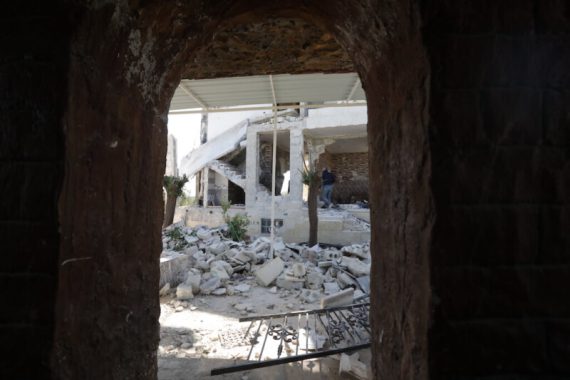W
ho was the leader of DAESH, Abu Hussein al-Qurashi? What path did DAESH follow after Abu Bakr al-Baghdadi? What are the details of the MIT operation? Why are all DAESH leaders nuteralized in Syria? What is MIT’s operational capacity and what are its implications?
Who was the leader of DAESH, Abu Hussein al-Qurashi?
If we take the declaration of DAESH as a milestone, Abu Hussein al-Qurashi is the fourth leader of this terrorist organization. After the killing of Abu Bakr al-Baghdadi on October 26, 2019, the second leader Abu Ibrahim al-Hashimi al-Qurashi was neutralized in February 2022 and the subsequent leader Abu al-Hassan al-Hashimi al-Qurashi was neutralized in October 2022, again by U.S.-backed operations. The last DAESH leader was neutralized by Turkey with a special team of the Turkish National Intelligence Organization (MIT).
There is no detailed information on DAESH leaders after Abu Bakr al-Baghdadi. As a matter of fact, there is no data even on the real name of Abu Hussein. However, according to a report by Anadolu Agency, he joined the organization in 2013 and rapidly rose in the ranks. This may be a clue that the younger generation in DAESH is more ambitious and proactive.
What path did DAESH follow after Abu Bakr al-Baghdadi?
On October 26, 2019, with the neutralization of DAESH leader Abu Bakr al-Baghdadi, the decline of DAESH, especially in Iraq and Syria, commenced. Although succeeding leaders tried to preserve the terrorist organization’s operational capacity, by 2019, it was long gone. With the killing of Abu al-Hassan in 2022, three DAESH leaders were neutralized within fifteen months. Although DAESH tried to carry out a restructuring process as it had done in the past (2010-2013), it has seemingly failed to do so.
In addition, not only the terrorist organization’s leadership but also its senior figures have been captured or neutralized. Despite these developments, the failure to rehabilitate the families and children of DAESH members, particularly in al-Hol Camp, and the refusal of their countries of citizenship to repatriate them have fostered the potential to create a new generation of DAESH members. Indeed, numerous local and international reports indicate a DAESH presence in these camps, especially in terms of ideological diffusion.
What are the details of the MIT operation?
It is known that the operation against Abu Hussein, the third leader to be neutralized after Baghdadi, was carried out on April 29. The public, both in Turkey and the world, was made aware of the operation by President Erdoğan’s statement on April 30. Afterwards, the details of the operation were shared through Anadolu Agency. It is reported that the operation against Abu Hussein lasted four hours and a call for surrender was made. It is understood that the operation was launched upon intelligence that Abu Hussein, who was in a building in the Afrin/Jindires region, was going to relocate.
The aim of the operation was to capture the terrorist organization leader alive. Examining the footage of the building where the operation was carried out, it is obvious that it was not subjected to aerial bombardment. The fact that the operation lasted four hours is proof that the MIT went to great lengths to capture Abu Hussein alive. It was also reported that Abu Hussein blew himself up to avoid capture. The previous leaders of DAESH, Abu Bakr al-Baghdadi and Abu Ibrahim also blew themselves up with suicide vests. It is understood that this has become a common practice within the terrorist organization.
Why are all DAESH leaders neutralized in Syria?
It is a remarkable statistic that Abu Bakr al-Baghdadi and all subsequent leaders of DAESH have been killed in Syria. As is known, although DAESH is an Iraq-based terrorist organization, since 2012-2013, it has spread to Syria where it has taken root, especially in terms of its leadership. What is more, except for Abu al-Hassan, who was neutralized in Daraa in the south, all the other leaders were neutralized in northern Syria. This indicates that DAESH elements think that they can camouflage themselves more easily in the liberated regions.
Indeed, these regions have been the epicenter of chaos and war for years. However, the facts that the borders have not changed since 2020 and that the war has continued as frontline clashes have allowed local security elements and the MIT to turn their attention to targeted killings. As a matter of fact, in recent years, the MIT has carried out many counterterrorist targeted killing.
Recommended
What is the MIT’s operational capacity and what are its implications?
The MIT’s neutralization of Abu Hussein is not widely discussed among the public, especially with Turkey approaching election day; however, it is certainly a sensational achievement. The last three DAESH leaders were killed by the U.S. with its decades of experience in the field, and this last neutralization showcases the MIT’s emergence on this stage and demonstrates its rapid progress. In addition to the MIT’s success against the PKK’s leadership cadre, especially in Iraq and Syria, the neutralization of Abu Hussein has made its targeted killing even more visible. The increasing number of unmanned combat aerial vehicle (UCAV) operations in Syria, especially after 2021, not only demonstrate the MIT’s operational capacity, but also its increasing dominance in Syria. The neutralization of Abu Hussein was a sign of this development.
The MIT’s success stories against terrorist organizations ranging from FETÖ to the PKK/YPG and DAESH are, in fact, among Turkey’s greatest institutional achievements. The MIT’s ability to capture terrorists from abroad, rescue hostages in Somalia, its contributions in Azerbaijan and Libya, and its neutralization of high-level terrorists in Iraq and Syria through targeted killing demonstrate its operational success. With the attention it has received from the international press, it is also evident that the MIT, like other intelligence services, has entered a process of international branding.





